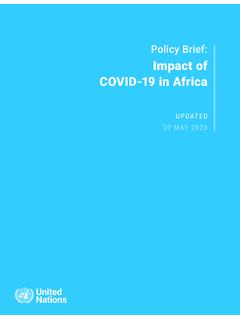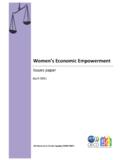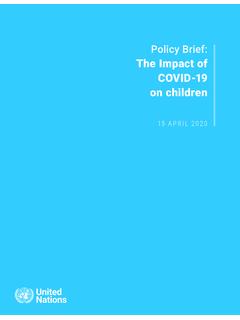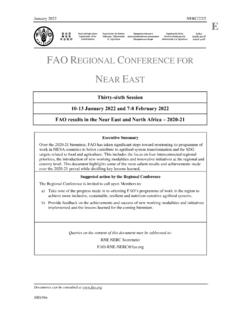Transcription of Impact of the financial and economic crisis on …
1 nutrition AND CONSUMER PROTECTION DIVISION Impact of the financial and economic crisis on nutrition Policy and Programme Responses Brian Thompson, Senior nutrition Officer Summary Increases in the cost of food often leads to changes in the quantity and type of foods that are purchased. This may result in a reduction in the amounts of foods consumed and/or the substitution of higher priced foods for less expensive foods which are often less nutritious. Over a prolonged period such changes may have negative consequences for nutrition , both through the quantity of foods consumed for maintaining energy balance as well as for the quality of foods consumed for maintaining sufficient intakes of proteins, fats and micronutrients such as vitamins, minerals and trace elements.
2 In adults this will affect the ability to do work and resist disease, and if this is situation becomes widespread and prolonged, it will act as a brake on the economy. In women of child bearing age this will reduce birth weight, increase the prevalence of low birth weight babies and increase maternal and child mortality. These foods are crucial for the growth and development of young children. For children the prevalence and severity of undernutrition, including stunting, micronutrient deficiencies, and wasting will increase as well as the number of child deaths from undernutrition. Higher expenses for food items will probably also lead to a decrease in expenditure on essential services ( heath expenses, school fees) which in turn can have immediate and long-term damaging effects on the growth of young children.
3 The overall result will be a halt to the progress which has been made in several countries toward achieving the MDGs. The nutritional consequences of increased food prices will have long-lasting detrimental effects and needs to be prevented vigorously. FAO s 2009 State of Food Insecurity (SOFI) economic Crises and Food Security: Impacts and Lessons Learned describes in detail the effects the current financial crisis has had on food security and on the numbers of the hungry and the malnourished. It observes that: The financial and economic crisis has greatest effects on the poor in least developing counties. Many, but not all, poor people will be able to maintain caloric intake in the face of economic crisis as they cut back expenditures on other essential items that may jeopardise longer term food security.
4 People will shift the composition of their food expenditures toward staple foods and away from more nutritious foods such as meat and dairy Distress sales of assets and cutbacks in health expenditures due to a temporary negative income shock can have permanent effects. A healthy agricultural sector can provide an employment buffer in times of economic crisis , especially in poorer countries financial and economic crisis should not be used as an excuse for postponing re-investment in pro-poor nutrition focused agriculture using a reinvigorated twin track approach for agricultural development In addition to the above, targeted direct nutrition interventions are required to help the hungry.
5 2 1. Background In responding to the FAO Director General s Initiative on Soaring Food Prices (ISFP), the Declaration of the High Level Conference on World Food Security made the commitment to eliminate hunger and to secure food for all today and tomorrow. It called for immediate support for increased agricultural production, particularly small-scale producers in low-income food-deficit countries and for those most affected by soaring food prices. Explicit in this is the call to urgently address hunger and malnutrition by ensuring that the poorest and most nutritionally vulnerable benefit from policies and programmes.
6 This includes in the short term resources for agencies to expand and enhance their food assistance and support safety net programmes and in the longer term, measures that fully embrace a people-centred policy framework supportive of the poor in rural, peri-urban and urban areas and people s livelihoods in developing countries . If the end result really is to address hunger and malnutrition, then we must go beyond the immediate need of simply providing basic inputs to stimulate production of staple crops and to boost smallholder food production. Rather, we need to focus more on people, not only on farms but on farmers and their families.
7 This is because increasing the availability and diversity of foods, although essential, is not always sufficient for reducing malnutrition. From a nutrition perspective, crop diversification is a means to improve the quality of the diet, the consumption of foods adequate in quantity and in quality in terms of variety, diversity, nutrient content and safety of foods. To achieve this, we need to ensure that crop diversification comprises a nutritionally adequate mix, and leads to dietary diversification. In this regard, a number of nutrition -related activities are required in which the nutrition and Consumer Protection Division of FAO (AGN) has a comparative advantage.
8 This includes actively encouraging the consumption of diversified diets, establishing safety nets and implementing specific social nutrition programmes for the poor and vulnerable who are unable to take advantage of increased production programmes, strengthening institutional capacity for ending hunger and malnutrition, assuring the safety of the food supply, and monitoring Impact on nutrition and foods consumed. 2. Consequences of the Slow Progress in Reducing Hunger and Malnutrition Reductions in hunger and malnutrition are proceeding too slowly to meet the Millennium Development Goal (MDG) target for halving hunger by 2015.
9 Although present global food supplies are more than adequate to provide everyone with all the needed calories, if the food were equally distributed, at the end of the decade, 925 million people have calorie-deficient diets. Even if a person consumes a sufficient quantity of food in terms of calories, this does not guarantee an adequate intake of the quality of food in terms of proteins, fats and essential micronutrients vitamins, minerals and trace elements. Micronutrient malnutrition, also known as hidden hunger , has serious public health consequences. For example, over one billion people consume diets deficient in iron.
10 Iron deficiency is responsible for roughly half of the global prevalence of anaemia. Iron deficiency anaemia causes 20 percent of global maternal mortality, can impair children s health and development and reduce adult work performance. Vitamin A deficiency disorders affect 40 million people causing blindness and contributing to infections and death. 3 Around the world 10 million children die before their fifth birthday every year. Over a third of these deaths are associated with undernutrition. One in three developing-country children under the age of five 178 million children suffers stunting due to chronic undernutrition and poor quality diets.














